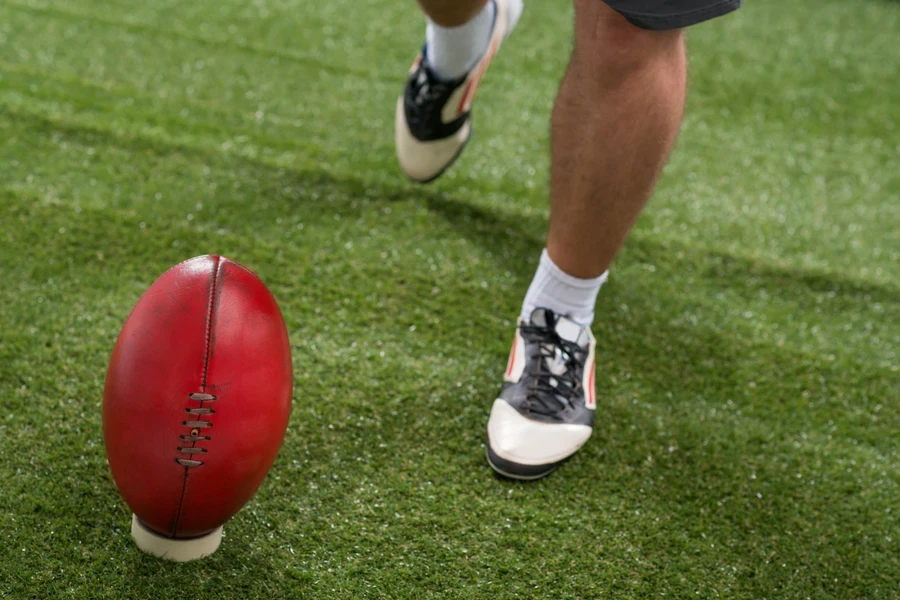Table of Contents
1. Introduction
2. Types of rugby footwear and their usage
3. Rugby footwear market trends in 2025
4. Key factors when selecting rugby footwear
5. Leading rugby footwear models for 2025
6. Conclusion
Introduction
Selecting the right rugby footwear is essential for enhancing performance on the field, especially for players who prioritize speed, agility, and precision. Designed to meet the unique demands of rugby, modern boots provide the support needed for quick direction changes, powerful sprints, and secure footing across various ground types. Whether it’s firm ground for dry conditions or soft ground for wet and muddy fields, choosing the right boots ensures that players can focus on their game without worrying about comfort or traction. With innovations in boot design, rugby footwear continues to evolve, delivering benefits for every position on the field.
Types of rugby footwear and their usage

Rugby boots come in various styles, each tailored to different playing surfaces and player positions. Choosing the right type of rugby footwear ensures optimal performance, whether for speed, agility, or traction. Here’s a guide to the main types of rugby boots and their applications.
Firm ground boots for dry conditions
Firm ground (FG) boots are ideal for dry and hard surfaces, such as natural dry grass or artificial pitches. These boots typically feature shorter, molded studs designed to provide stability and grip on firmer ground. They are lighter and often used by players who need to make fast, agile movements. The design of FG boots helps maintain speed while ensuring sufficient traction on harder surfaces.
Soft ground boots for wet conditions
Soft ground (SG) boots are essential for wet, muddy conditions commonly found during rainy seasons. These boots have longer, removable studs, which penetrate soft surfaces to offer better grip and prevent slipping. SG boots are particularly useful for players involved in more physical aspects of the game, such as scrums and tackles, where stability and traction are crucial. The stud configuration helps players maintain balance and control, even on muddy, slippery fields.
Football-style boots for rugby backs
Recently, there has been a growing trend of using football-style boots in rugby, particularly among backs. These boots are lighter and designed to enhance speed and precision, making them ideal for players who rely on quick direction changes and agility. Although traditionally heavier rugby boots were preferred, the shift towards football-style boots reflects the emphasis on speed and flexibility, especially for backs who play a fast-paced game.
Rugby footwear market trends in 2025

Rugby Market Overview in 2024
As of 2024, the global rugby market, including rugby footwear, stands at an estimated value of approximately USD 4.01 billion, with forecasts indicating growth to around USD 6.3 billion by 2030. This projected growth reflects a compound annual growth rate (CAGR) of about 6.3% from 2023 to 2030. Key drivers for this expansion include rising global interest in rugby as a popular sport and fitness activity, alongside advancements in high-performance gear, according to insights from Future Data Stats.
Technological advancements in rugby boots
In response to increasing demand for performance-optimized footwear, rugby boots have seen significant technological upgrades. The latest designs emphasize lightweight materials that enhance agility and speed, alongside advanced cushioning for added comfort and impact protection. Updated stud configurations further enhance grip and control, especially useful for quick directional changes. These innovations cater to diverse player roles, providing tailored options for both speed and stability, thus meeting the varied demands of backs and forwards on the field.
Global market growth
In 2025, the market has also responded to the growing popularity of artificial pitches, such as 3G and 4G surfaces, by producing rugby boots specifically designed for synthetic grounds. This shift has prompted manufacturers to focus on enhanced comfort and durability suited for artificial fields. Additionally, as sustainability takes center stage in consumer preferences, eco-friendly rugby footwear options are gaining traction. Many brands are incorporating recycled materials and ethical manufacturing practices into their products, aligning with industry-wide efforts to reduce environmental impact and appeal to environmentally conscious consumers.
Key factors when selecting rugby footwear

Surface type and stud configuration
The playing surface is a critical factor when selecting rugby boots. Soft ground boots, designed specifically for wet and muddy conditions, feature longer, often metal, studs that dig deep into the ground to provide superior grip and prevent slipping. These boots are essential for maintaining traction during quick movements and scrums. On the other hand, firm ground or artificial surfaces demand boots with shorter, molded studs. These offer stability and help players avoid injuries by distributing pressure more evenly across the foot. For players who encounter varying field conditions, hybrid boots provide adaptable stud configurations, allowing players to perform optimally on both soft and firm grounds without needing to change footwear.
Fit and comfort
Proper fit is fundamental to both comfort and injury prevention. Rugby boots should fit snugly around the foot, ensuring that the player feels secure but not restricted. This helps maintain stability and reduces the risk of blisters during intense play. The right boot should leave a small gap—roughly a thumb’s width—between the longest toe and the front of the boot. Additionally, it’s important to match the width of the boot to the player’s foot shape, as a poor width match can cause discomfort and negatively affect performance. Boots designed with a wider fit are often ideal for players with broader feet, helping them avoid tightness and providing better overall comfort throughout the game.
Durability and maintenance
Rugby is a physically demanding sport, and the durability of the boots plays a crucial role in performance. Boots need to be made from sturdy materials that can withstand constant contact and movement. This is particularly important for players in forward positions, where scrummaging and tackling place extra stress on footwear. Regular maintenance of the boots can also significantly extend their lifespan. After each game, cleaning the boots thoroughly and allowing them to air dry naturally helps preserve the materials and structure. This care ensures that the boots remain in good condition, even with frequent use on tough surfaces, allowing players to get the most out of their investment.

Leading rugby footwear models for 2025
Rugby footwear in 2025 is designed to meet the demands of faster and more dynamic gameplay. The latest boots prioritize lightweight construction, improved agility, and enhanced durability, making them essential for players at every position.
Speed-focused boots
Rugby boots designed for speed are crafted from lightweight materials to maximize agility and quick movement. These boots often feature specialized outsoles that improve grip and allow players to accelerate and change direction with ease, making them ideal for backs who rely on speed to outmaneuver opponents. Advanced cushioning is also incorporated for comfort, without sacrificing stability, ensuring that players can maintain balance while moving at high speeds. The combination of lightweight construction, enhanced traction, and cushioning support allows for rapid play on firm ground, giving players the freedom to perform quick sprints and agile cuts across the field.
Versatile boots for different conditions
Versatile rugby boots are built for adaptability, with adjustable stud configurations that allow players to switch between soft and firm ground as needed. These boots feature removable studs that can be customized to suit different playing surfaces, ensuring reliable traction whether the field is wet and muddy or dry and firm. By offering both stability and speed, these boots maintain performance across a variety of conditions, making them an ideal choice for players who regularly face changing field environments. Their flexibility eliminates the need for multiple pairs of boots, providing both speed and dependable grip in one package.
Durability and comfort

Durability remains a critical factor for rugby boots in 2025, particularly for players involved in physically demanding roles like forwards. These boots are built with reinforced materials and sturdy construction to withstand the pressures of scrums, tackles, and constant physical contact. The robust design helps prevent wear and tear over time, even under extreme conditions. In addition to durability, many modern boots emphasize comfort, integrating features like improved foot support and cushioning to reduce the risk of blisters and other foot-related injuries. A proper fit is essential for both performance and protection, ensuring that the boots stay secure during intense play. Regular cleaning and maintenance are also key to extending the lifespan of the boots, keeping them in top condition throughout the season, despite frequent use on tough surfaces. By balancing durability with comfort and fit, these boots offer long-lasting performance even in the most challenging environments.
Conclusion
Choosing the right rugby footwear is essential for achieving optimal performance in 2025. The best boots not only cater to different playing positions but also consider the surface conditions—whether firm, soft, or artificial. The latest advancements, such as lightweight designs and improved traction systems, ensure that players can perform with agility and control on various fields. By focusing on key factors like durability, fit, and versatility, players can enhance their game while minimizing the risk of injury, making thoughtful footwear selection a crucial part of rugby success.




